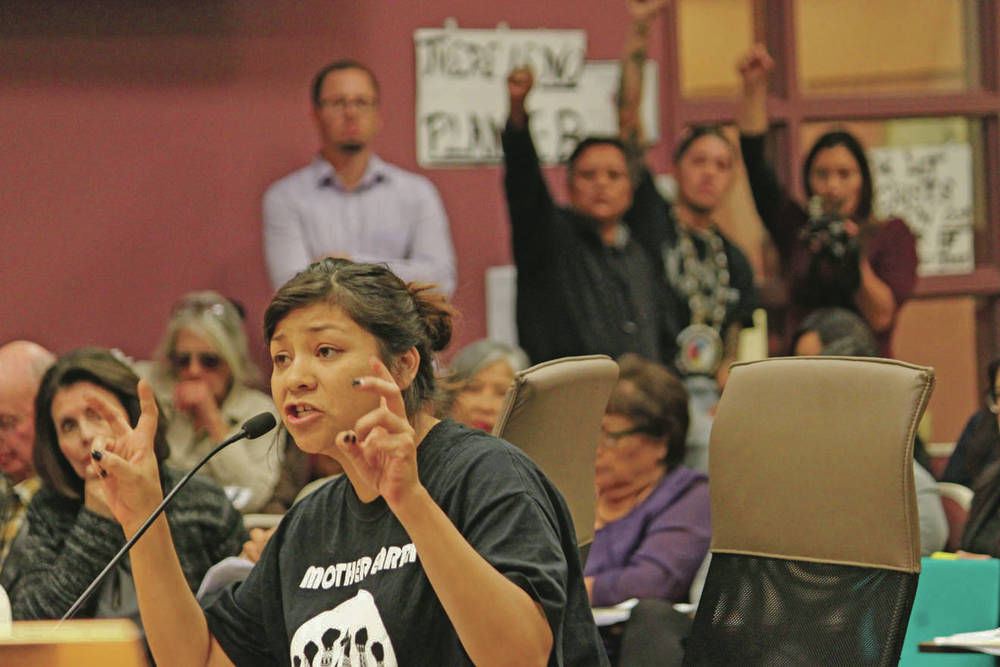
BERNALILLO — Elected leaders in one New Mexico county are considering an ordinance that would guide energy development across a large swath of land that borders the state’s largest metropolitan area as well as numerous Native American communities.
Sandoval County’s proposed regulations have generated much debate and the interest continued Thursday night as a crowd packed the commission chamber, some holding signs of protest that mentioned toxic waste and polluted water. Dozens more gathered downstairs to watch the proceedings via a large monitor.
Activists have raised concerns about the potential environmental effects, arguing that the proposed rules would pave the way for more drilling with few safeguards in what they call a pristine stretch of the state. Many asked the commissioners to table the proposal pending further analysis and more discussions with the public and tribal communities.
Several pueblo governors attended the meeting along with state lawmakers whose districts include parts of the sprawling county.
Sandia Pueblo Lt. Gov. Lawrence Gutierrez said his tribe is concerned about water quality and quantity, noting that supplies are uncertain in the arid state. He pointed to the billions of gallons used annually by oil and gas producers in other parts of the state.
“This ordinance doesn’t go far enough,” he said.
Supporters, meanwhile, highlighted the industry’s multibillion-dollar role in New Mexico’s economy and the need to fill a current regulatory void for the sprawling county.
The meeting was expected to last hours.
In the works for about two years, the ordinance would establish buffer zones and require energy companies to have at least a $5 million insurance policy if they want to drill on the county’s unincorporated lands. The ordinance would not affect state or federal regulations already in place.
Commission Chairman Don Chapman said earlier Thursday the ordinance is fairly restrictive but recognizes that oil and gas operations already exist in the county.
“There’s this misconception that what we’re going to do here in Sandoval County is pass out tickets for people to come in here and frack. The reality is it’s been going on without an ordinance,” he said, referring to hydraulic fracturing — a process that boosts production by injecting a high-pressure mix of water, sand and chemicals underground to break open rock formations.
“I really feel like our ordinance moves the county forward in terms of holding the industry accountable and providing a level of protection that currently doesn’t exist for the citizens that live here,” Chapman said.
Activists and environmental groups argue that the ordinance offers little in the way of protections, with the chief concern being the region’s subsurface drinking water resources.
The proposed ordinance would ban drilling within 750 feet from homes, schools, hospitals, churches, cemeteries and fresh water supplies. It also asks that areas be fenced and that operators provide certificates showing they have safe water use agreements and cleanup plans for when their wells are plugged.
Any violations would result in a $300 fine.
While energy companies have operated for decades in areas along the edge of the San Juan Basin, there has been little interest in Sandoval County’s southern, more populated reaches.
While the New Mexico Oil and Gas Association generally does not support such local ordinances, spokesman Robert McEntyre said it appears the county is trying to strike a balance even though current market prices are far from the point of encouraging companies to look outside of the state’s traditional oil and gas hotspots, which include the San Juan Basin to the north and southeastern New Mexico’s share of the Permian Basin.
“The idea that we’re all of a sudden going to be drilling in someone’s neighborhood or backyard is farfetched,” he said, adding that the buffers called for by the ordinance would be the most stringent in the state.